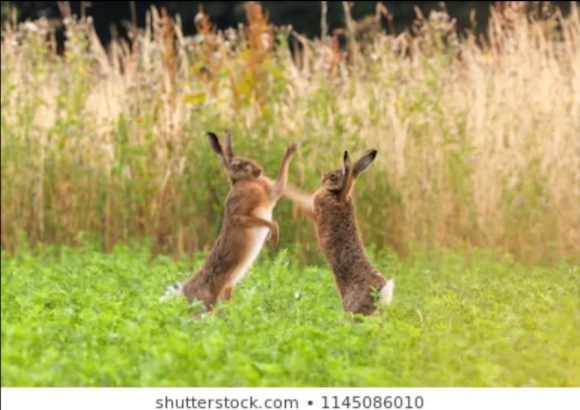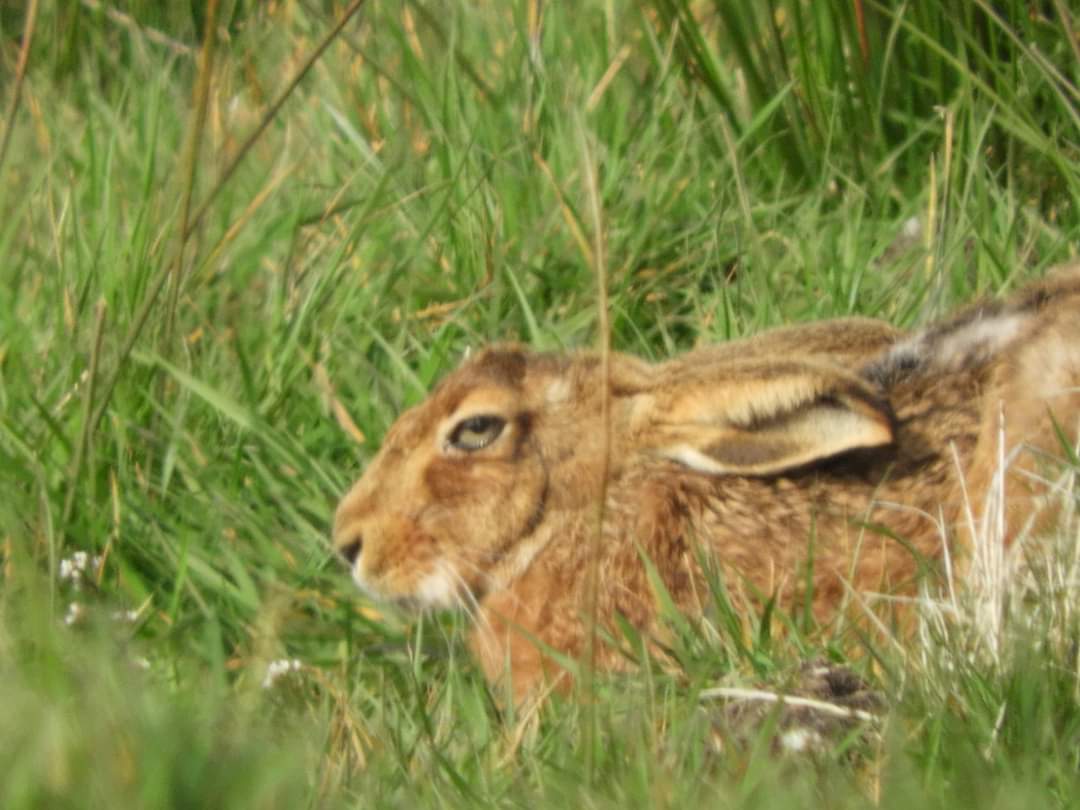Thank you to Gary Reynolds for the featured photograph.
Mad as a March Hare! This idiom has been in use since the 16th Century and was popularised in Lewis Carroll’s famous book ‘Alice’s adventures in wonderland’. I’ve yet to witness a hare’s mad antics in the spring and although I see them fairly regularly when driving through Carmarthenshire’s lanes, they are certainly a less common sight than in the past. When Lewis Carroll was writing about the Mad March Hare in 1865, there were around 4 million hares in Britain, but numbers have sadly declined by 80%.
But why do we associate them with madness? On a March moonlit night, if you are very lucky, you may get the opportunity to witness hares preparing to pair up and mate. Males will chase the larger females, who will sprint away with their infamous speed – some have been recorded to reach more than 45 mph! Males will fight off rivals in the chase, and the females will box and send any unsuitable suitor packing if they don’t have the speed, stamina and strength to meet the female’s expectations.
Hares are able to breed several times a year and can in fact mate and then store a fertilised embryo whilst still pregnant. Once the litter is born, the embryo implants ready for the next litter. These icons of fertility are said by some people to have given rise to the legend of the Easter bunny and its associations with new life. The hare has some other interesting biological adaptations to enable it to be resistant to high speed, it is the only mammal with a jointed skull. This helps absorb the shock of hitting the ground at such force when jumping.
Within Carmarthenshire, there was a study in 2012 that looked at a number of priority species and the effects of Welsh agri-ecology schemes. The data from this research and other records in the county show that most of our county’s hares are found on the edges of uplands – the areas where there are rushy fields and sheep grazed areas.
These areas provide a safer base for their nests, called forms, and they can lie up out of sight in the rushes and use the open fields to graze. A hare’s main defence is its speed and open fields where predators can be spotted easily, with clear lines of escape are preferable. These are safer than lowland silage areas where young leverets can be killed by silage cutting. Rabbits give birth to their young safely underground where they are born blind and helpless whereas a hare’s young need to be able to fend for themselves to increase their chance of survival in their forms above ground.

People have been mesmerised by the hare since early times and it holds a place in the folklore of many cultures. The hare’s association with the moon is well known and in Japan, Mexico and China, people talk of the ‘hare in the moon’ rather than the ‘man’ when they gaze into the night sky and make shapes from the dark patches on the lunar surface.
The hare holds a special place in the hearts of Celtic people and the Mabinogion story of Ceridwen and Gwion tells how Gwion transformed into a hare and was chased by Ceridwen in her guise as a greyhound. She eventually caught him when he had further transformed into a grain of corn and was devoured by Ceridwen, who was by then a hen. This grain of corn developed inside her and was born as Taliesin, the legendary bard. Thus new life came about and this brings us back neatly to the hare’s associations with fertility and our own town and Black Book of Carmarthen in which Taliesin features.
I’ve often wondered why rabbits are kept as pets whereas hares are not generally domesticated. I researched the history of both species and found that of the three types of hare found in the British Isles, the Brown hare was introduced – and is now considered naturalised, whereas the Mountain hare in Scotland and its subspecies the Irish hare are native to our shores. Rabbits are said to have been introduced as a food source during the Norman Conquest. The European rabbit which was originally used for food and fur has been domesticated and selective breeding has been used to create more than 300 different rabbit breeds. I considered whether the precocial nature of hares was significant in them not being domesticated, hares are born relatively mature and mobile with hair and good vision, while rabbits are altricial, born hairless and blind, and requiring closer care. Is a rabbit easier to tame because it is more dependent when young? Hares live a relatively solitary life in a simple nest (form) above the ground, while most rabbits live in social groups in burrows or warrens, perhaps this less social nature of hares also makes then less suitable as pets?
I searched for examples of domesticated hares and was directed to an article about the English poet, William Cowper (pronounced Cooper). He also wrote hymns and is said to have changed the direction of 18th century nature poetry. Cowper was admired by William Wordsworth, and Samuel Taylor Coleridge rated him as the “best modern poet”. He was a man who struggled with self-doubt and overwhelming feelings of depression. He was passionate about anti-slavery and was anti-hunting and he was also responsible for the oft quoted line “God moves in a mysterious way” which came from his poem, Light shining out of darkness. I didn’t think I was familiar with Cowper when I was told about him, but soon found I was aware of many of his hymns and also another of his famous lines, “Variety’s the spice of life”. Cowper had three pet hares that brought him much joy in the many hours of darkness he endured in his life. He described them in a series of letters and I’ve attached an article that reproduces some of them and which is well worth a read. I can’t do justice to his work by describing his hares to you, Cowper has such a wonderful way with words that captures the nature of these animals alongside the nature of the time it was written.
What is apparent is hares have individual personalities much in the same way as other mammals do and they can clearly be tamed and live with humans and other animals as pets. I’m jealous of Cowper and his original therapy animals, but I’m relieved that hares aren’t regularly kept as pets; because for me, they will always have a sense of mystery and a special place in mythology.
I hope you have enjoyed my blog – please like and share it if you wish! Check out other people’s blogs on https://blog.feedspot.com/uk_wildlife_blogs/
